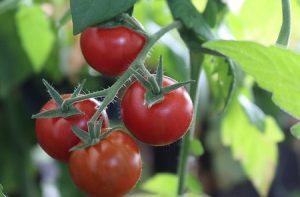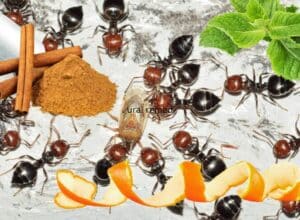Last Updated on October 18, 2023
Asian fruit trees are one of the most popular types of fruiting plants grown in home gardens, both because they bear delicious fruits and because their ornamental value is often great as well.
Let’sl explore 9 different types of Asian fruit trees that can be grown in the United States. Each tree comes with a brief overview of its key characteristics and growing requirements, so you can decide which one would be the perfect addition to your garden. Keep reading to discover which Asian fruit tree piques your interest the most!.
Asian Fruit Trees List
- Asian Pear
- Fig
- Loquat
- Mulberry
- Pomegranate
- Kumquat
- Asian Persimmon
- Jujube
- Satsuma Mandarin
If you’re short on time and can’t read the full article, here’s my top recommendation for the best Asian tree to add to your home garden.
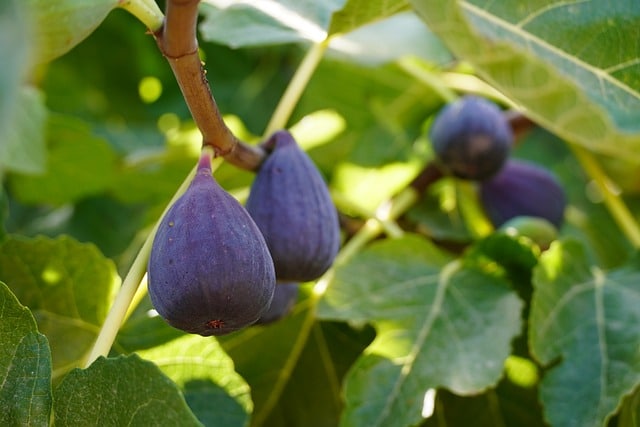
Figs are popular for their ease of cultivation and hardiness, and can be grown in a wide range of climates across the US. You can get a live fig tree on Amazon.
*This post contains affiliate links. If you choose to purchase any of the products I have recommended, I may receive a commission at no cost to you.
A note before we proceed:
The majority of Asian fruit trees will do best in warm climates. If you don’t see your favorite tree suitable for growing outside according to the USDA hardiness zone you live, don’t fret! For those who’re living in colder zones, planting dwarf varieties of Asian trees in pots and bringing them indoors during winter is a great idea. Just make sure that they have plenty of sunlight so plants are able to produce fruit.
1. Asian Pear (Pyrus pyrifolia)
Grows in USDA hardiness zones: 5-9
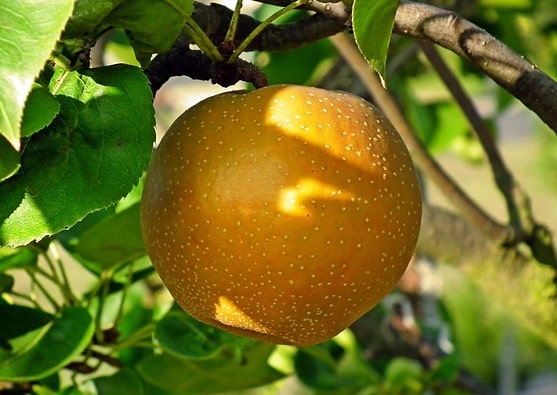
Native to East Asia, Asian Pear trees are easy to grow and produce a bountiful harvest. As such, they make for excellent landscape plants that reach as tall as twenty feet! Some varieties of the Asian Pear tree can be self-fertile but most need another variety nearby in order to bear fruit on a regular basis. So don’t forget this when you’re getting your new plant!
Asian Pears are like a crossover between pears and apples. They are typically round with bronze or golden skin and have a crisper texture than European pears. The flesh is juicy, and the flavor is very sweet. You can enjoy Asian pears fresh, or use them in salads. You can even grill them, so give them a try!
How long does it take for an Asian pear tree to produce fruit?
2 years
Best Asian pear varieties:
- Self pollinating – Nijisseiki, Shinseiki
- Cultivars that need another variety of Asian pear tree nearby for cross pollination to produce fruit: ‘Shinko’, ‘Kikusui’, ‘Korean Giant’, ‘Shin Li’, ‘Yoinashi’
Asian pear trees are readily available for purchase online at Nature’s Hill Nursery, Amazon.
Read more information and advice on how to chose and grow Asian Pears
2. Common Fig (Ficus carica)
Grows in USDA hardiness zones: 6-10

Fig trees originated in Western Asia. Figs are popular trees grown for their soft and sweet fruit that can be enjoyed right from the tree or dried. Even though they are small, figs have a lot of fiber and minerals. Dried figs contain more calcium than other dried fruit.
Figs grow with ease in full sun and well-drained soil, they will even thrive as shrubs if you allow them to do so. Fall is a great time to plant fig trees because these fast-growing plants will have plenty of time to establish healthy roots before winter frosts arrive and they go into dormancy. Just keep in mind that a fig tree has an extensive root system, so consider where you plant it beforehand!
Read related: Planting fruit trees in fall
How long does it take for a fig tree to produce fruit?
You can pick fruit after the first year.
Best fig varieties:
Popular fig varieties for home gardeners. Brown Turkey, Black Mission, Dottato (Kadota), Scott’s Black Fig, Brunswick, Osborn Prolific, and Celeste.
Plantingtree.com is the best place to get fig trees at a very reasonable price.
3. Loquat (Eriobotrya japonica)
Grows in USDA hardiness zones: 7 – 11
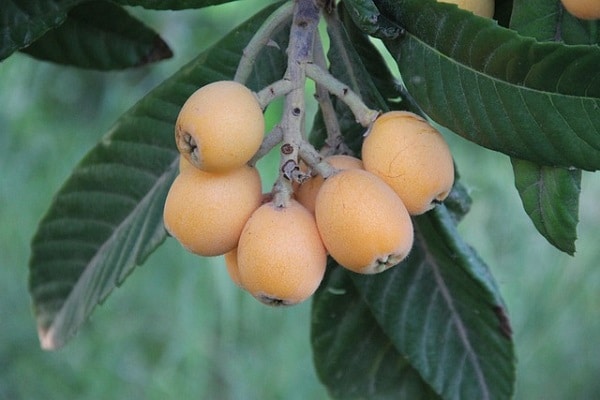
Loquat is native to the colder region of China. It’s often called “Japanese plum.” Its exotic fruits can be oval, round, or pear shaped depending on cultivar. Fruit can taste sour or sweet, which depends on the cultivar too. Loquat’s unusual fruits grow in clusters, and are small in size (1”-2”) with yellow or red-orange skin and soft white, yellow or orange flesh. They taste like a combination of plum and kumquat.
Loquat tree care is pretty basic: plant it in well-drained soil in a sunny spot and give plenty of water.
How long does it take for a loquat tree to produce fruit?
3 years
Best loquat varieties:
Gold Nugget (mildly sweet), Oliver (very sweet), Thursby (sweet-tart)
4. Mulberry (Morus)
Grows in USDA hardiness zones: 4-8

Mulberry trees originated in China and the Chinese discovered that their silkworms loved leaves from White Mulberry trees.
I guess none of us are planning on raising our own silk worms for silk production 😊, but planting mulberries just because they’re so delicious sounds like a great idea! You can eat them fresh or dried, you can freeze them or use them to make jellies, jams and even mulberry wine. One bad thing – birds love these berries too–so get ready for competition who will snatch up all your delicious fruit first.
Mulberry trees are large, some varieties can grow up to 60 feet, but you can get dwarf varieties perfect for growing in pots. These trees are self fruitful, drought tolerant once established and require very little care, so why not to get one for your yard?
Plant a mulberry tree in full sun, just avoid planting over the patio or concrete walkway, because fruit will drop and stain.
How long does it take for a mulberry tree to produce fruit?
about 3 years
Best mulberry varieties
‘Beautiful Day’ (white fruit), ‘Dwarf Everbearing’ (black fruit), ‘Kokuso’ (large black fruit), Riviera (purple black fruit, everbearing).
How to grow a tree in a pot
If you do not have a big backyard or live in a colder climate, you can grow a dwarf Asian fruit tree in a pot.
If you do, just make sure that the container is about twice as large as your plant came in and use well-balanced potting soil to fill it up.
After that’s done, place the fruit-bearing tree on some sunny spot indoors near windows facing east or south for best results or in a sunny spot on your porch.
As for routine watering, simply check the soil with your index finger. If the soil is dry about 3 inches down, water your Asian dwarf tree.
5. Pomegranate (Punica granatum)
Grows in USDA hardiness zones: 7 – 10
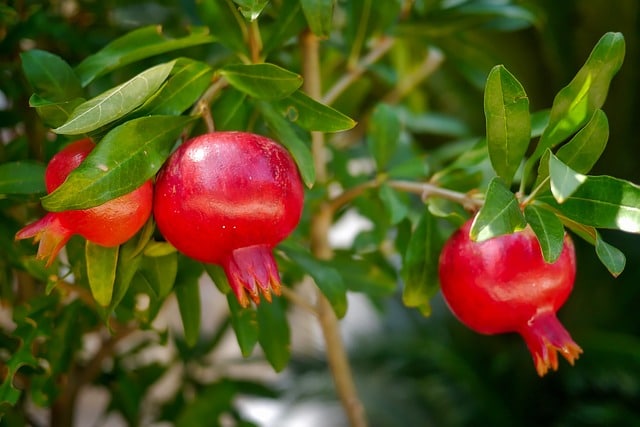
The pomegranate fruit tree originated in Iran. It’s Latin name “Punica granatum” means “apple with many seeds”. Because of the profusion of seeds, pomegranate became a symbol of abundance and prosperity. And we all want prosperity, don’t we?😊 So why not get a pomegranate tree for your home orchard.
Additionally, a pomegranate is a fruit that contains a lot of nutrients. Some studies say it has as many antioxidants as green tea and red wine.
Pomegranate plants are easy to grow and require little maintenance once established. They perform best when planted in full sun. You can grow pomegranate as a shrub or as a tree. Pomegranates form lots of suckers from the base, and if you don’t remove them often, the plant quickly creates many stems. The pomegranate tree grows 12 to 20 feet tall, will blossom the next year after planting and even can make 2 or 3 fruits, but you can expect a good harvest in the 3rd year after planting.
Cut fruit from the tree as soon as it turned fully red. Slightly unripe fruit can store for many months if you provide it cool and dry conditions.
How long does it take for a pomegranate tree to produce fruit?
3 years
Best pomegranate varieties:
‘Wonderful’, ‘Pixies’, ‘Surh-Anor’
6. Kumquat (Citrus japonica)
Grows in in USDA hardiness zones: 8-11
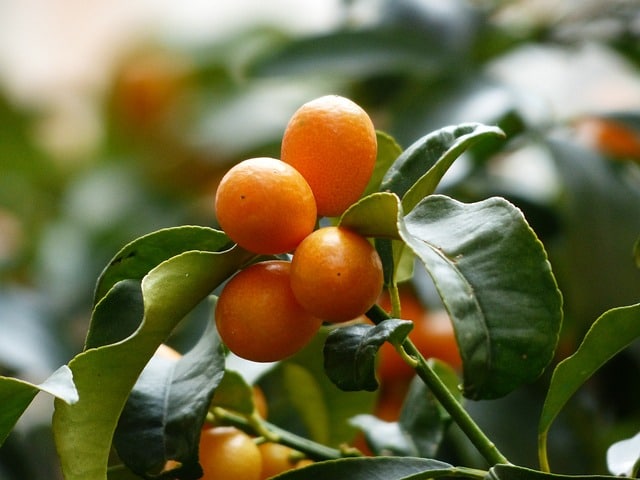
Originated in China, the kumquat tree is one of the most cold-hardy citrus trees you can find.
The tree itself doesn’t grow very tall. It blooms with sweet-smelling white flowers and produces small oval or round fruits with thin edible rinds. Kumquat fruit can be eaten whole – unpeeled, or used for various recipes including jellies, salads, desserts sauces, and liqueurs!
How long does it take for a kumquat tree to produce fruit?
2-3 years.
Best kumquat varieties
Kumquat varieties most commonly grown nowadays include: Nagami (produces sour fruit), Meiwa (produces sweet kumquat), Calamondin (a cross between a tangerine and a kumquat).
Shop Dwarf Kumquat Trees now at citrus.com
7. Asian Persimmon (Diospyros kaki)
Grows in USDA hardiness zones: 7 – 11
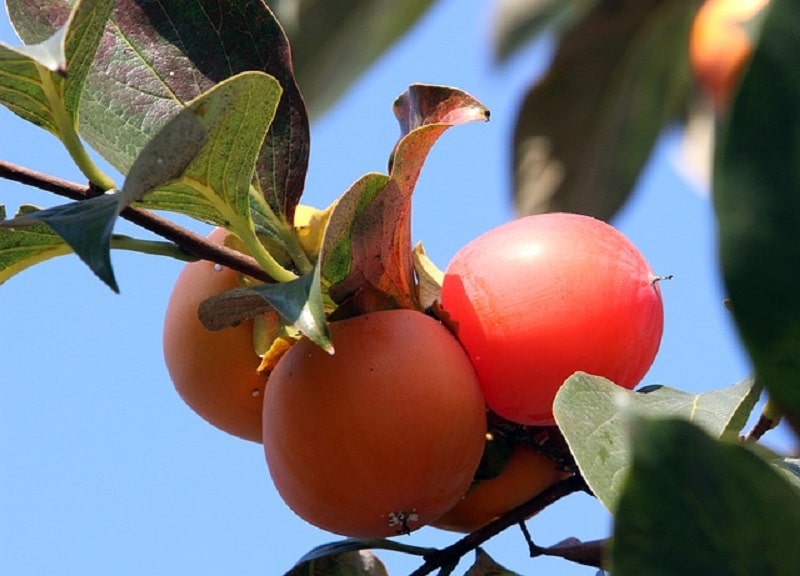
The Asian persimmon tree – it’s a wonder to behold! This attractive plant produces an abundance of tasty orange-colored delicious fruit in October-November and becomes an absolute showstopper in your neighborhood. The fruits are perfect for eating fresh or drying out as well.
Asian persimmons bear fruit without pollination – it doesn’t need another persimmon tree nearby to produce fruit. The majority of cultivars withstand temperatures down to 10°F and require about 100 hours of temperatures below 45°F to blossom and fruit.
You should harvest Asian persimmon by clipping fruit from the tree. Pick astringent cultivars when they are soft and their skin is translucent. Harvest non astringent cultivars when they are fully orange but still firm.
How long does it take for an Asian persimmon tree to produce fruit?
Grafted trees will bear fruit in 1-2 years after planting.
Best Asian persimmon tree varieties:
8. Jujube (Ziziphus jujuba)
Grows in USDA hardiness zones: 5-10
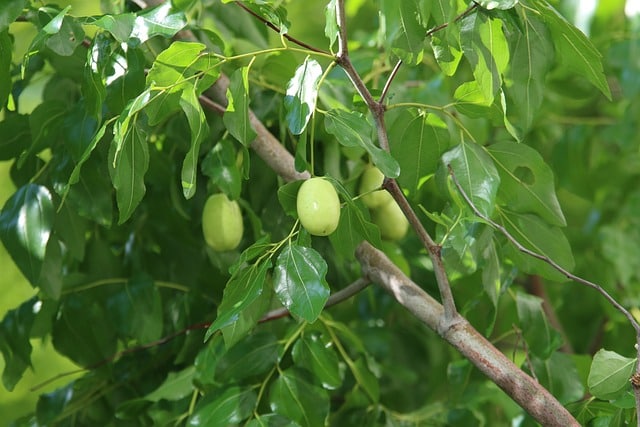
Native to Asia, jujube trees are best grown in warm climates where fruits can fully ripen during warm summer. These trees aren’t fussy about soil, grow typically 15-30 feet tall, and look beautiful in landscapes. They can withstand heat and drought, but deep watering is recommended. It’s better to plant two trees to increase the fruit set.
Jujube is often called “the Chinese date” because it looks and tastes like the date when dried. Jujube fruit is used in cooking in Eastern cultures and all over the world. These rare fruits are cherry to plum sized with mahogany skin and white crisp flesh! They taste great fresh or dried.
How long does it take for a jujube tree to produce fruit?
2-3 years
Best jujube varieties for home garden
Popular jujube varieties: Honey Jar, Sugar Cane, Sherwood, Lang, Li, Chico.
Where to buy jujube trees online:
9. Satsuma Mandarin (Citrus reticulata)
Grows in USDA hardiness zones: 9 -11

Satsuma is the hardiest of all the mandarin trees and can survive temperatures in the upper teens or low 20s.
The satsuma variety produces an incredibly flavorful seedless fruit that needs to be picked as soon as it starts to get ripe.
The tree is self-fertile. Evergreen Satsuma mandarin tree is a slow grower. It reaches just 15 feet in its maturity, or only 6’ if grown in a pot, that’s why the Satsuma mandarin tree is perfect for growing in containers. It requires a full sun exposure and grows best if fed with a citrus fertilizer in early spring.
How long does it take for a satsuma mandarin tree to produce fruit?
2-3 years if you get a grafted tree, 7 years if grown from seed
Where to buy satsuma mandarin trees?
Are you interested in purchasing your own satsuma mandarin tree? Check out the citrus.com banner above for more information and to get your 10% discount!
—————————————-
This YouTube video will give you some useful tips on growing a Satsuma mandarin tree .
Other Asian fruit trees that grow in the United States
(but didn’t make it to the top 9 list)
- Asian giant guava, carambola, lychee, mango, pomelo, majority of citrus trees didn’t make to the list because they need a tropical climate to flourish and will be hard to grow in the U.S.A. unless you live in parts of Florida, California, Hawaii or US Virgin islands.
- Umeboshi (Prunus mume), known as Japanese apricot or Chinese plum tree, can grow in USDA hardiness zone 6-8. Yet the fruit is very sour and potentially poisonous because it is laced with cyanide. It’s used in Asian cooking when fruit is smoked, boiled or cured with sugar, salt or alcohol. So unless you are an Asian chef, don’t bother growing it
- Kiwi fruit is not on the list because though it’s an Asian fruit originated in China, it’s a vine, not a tree. You can grow fuzzy Chinese kiwis if you live in USDA hardiness zones 7-9.
- Nectarine While nectarines may not be as commonly associated with Asian fruit trees, they do have a long history of cultivation in Asia and are a delicious addition to any home garden. Nectarines are believed to have originated in China more than 2,000 years ago, and were later introduced to Europe and North America. Today, nectarines are widely cultivated in many regions of the world, including the United States, where they are grown commercially in states such as California and Georgia.
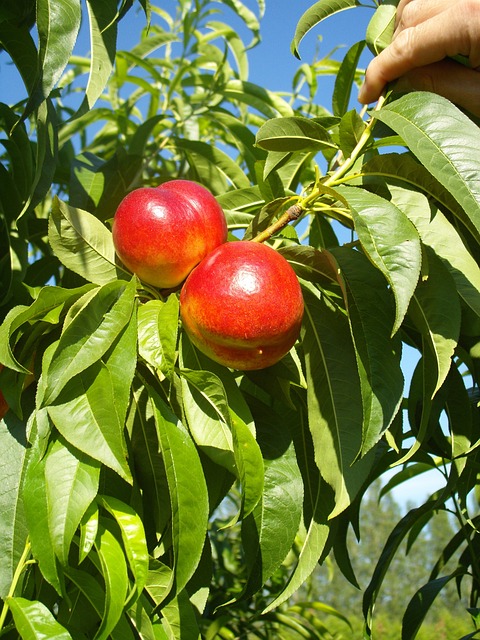
Other types of fruit trees that are native to Asia
There are several other types of Asian fruit trees that can be grown in home gardens (not in the U.S.A. unless it’s a dwarf indoor plant) depending on the climate and growing conditions.
- Dragon fruit (also known as pitaya)
- Durian
- Longan
- Lychee
- Mango
- Guava
- Starfruit (also known as carambola)
- Jackfruit
- Rambutan
- Passionfruit
Related reading:
More informational articles on growing trees
Final thoughts on Asian trees you can grow at home for delicious fruit
The Asian fruit trees for a home garden we’ve talked about are all easy to grow and produce an amazing variety of fresh, nutritious fruits. And the best part is that they can be grown in your backyard or a pot at home!
I hope this article has helped answer some questions about which types of Asian fruit trees work well in North America. Leave a comment if you have any questions. And if you like this article, don’t forget to share on social media.
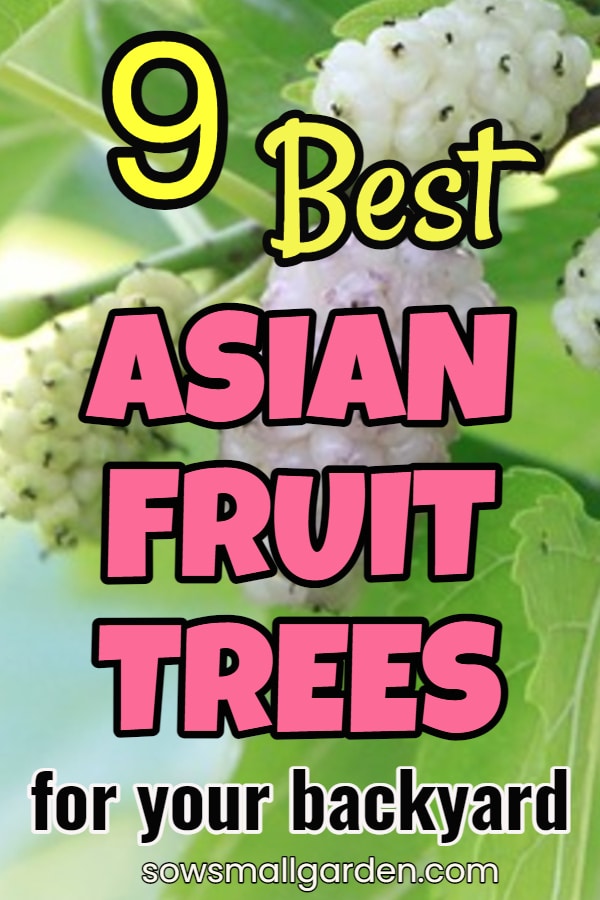
Pin for later reference!
Image source: Pixabay (CC0 License)
You have read:


